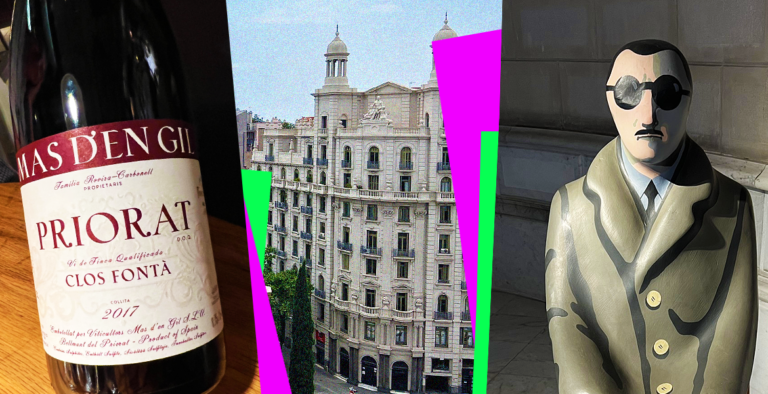Letters from Barcelona: On banned works and the art of balancing local interests and tourism
The day before I arrived in Barcelona, apparently thousands of Spaniards had taken to the streets in the city and on the islands to protest mass tourism and overcrowding.
According to reports, “On June 8th, up to 3,000 young people demonstrated in Barcelona, shouting slogans such as ‘Tourists go home,’ ‘Tourism is ruining the neighborhood,’ and ‘Tourism is ruining the city,’ and they also wrote graffiti on bus stops and walls saying ‘Tourism is ruining the city.'”
I saw nothing of the sort and experienced no hostility the next day as I wandered the city as a tourist, blending in with thousands of other tourists like me, exploring and discovering the wonders of a city that attracts 30 million people a year.

There were events everywhere, from the food festival on Las Ramblas to, as Mateu Hernández of Barcelona Tourism Board said on stage at Focusrite Europe, the Sónar festival, which has been running for 30 years and gives local entrepreneurs a global reach.
I visited the Prohibi Museum, which displays a variety of banned and forbidden artworks through the ages, collected by a local journalist in Barcelona. Located in the same building where I visited a contemporary art and NFT exhibition a year ago, I was reminded of how ephemeral things can be: one moment it’s the hottest thing since sliced bread, the next it’s evaporated into the ether, lingering in some remote crevices of human consciousness.

I wonder if the same can be said about AI, although I think many would say that this intelligence, whether auxiliary, augmented, or artificial, will not only be long-lasting, but will become a part of us, like electricity or oxygen, without us knowing or thinking about it.
It’s interesting to see the different artworks that offended certain demographics at different times in history. Common themes are sex, religion and politics. There are Andy Warhol’s portrait of Mao Zedong and Robert Mapplethorpe’s sadomasochistic portraits, and I didn’t know that 86-year-old Picasso created “Suite 347”, a series of 347 etchings, in just seven months. They depict scenes from his life, including “the most erotic scenes” of the painter Raphael and his mistress La Fornarina. “Raphael’s fiery relationship with his model helped Picasso to break away from his uninhibited voyeurism by adding the figure of the Pope secretly watching them,” the description reads.
Apologies for not being able to share these etchings, you’ll have to go to Barcelona to see the real thing.
Of course, religion was a major theme, and many works were deemed blasphemous or offensive to certain segments of the public and to public figures with censorship power.
The artwork reminded me that a vocal minority can often create uproar over things that the majority of us consider acceptable and okay.
But that doesn’t mean their voices should be ignored. Local protests against mass tourism and overcrowding are taking place not only in Spain and other parts of Europe, but also in parts of Asia, such as Bali and Tokyo. Locals may not be as combative or vocal, but they need to be listened to.

When I discussed the matter with Rod Cuthbert, founder of Viator and Tourism Tasmania executive director, he said, “This is a real issue and it seems to be gaining momentum. We definitely need to get ahead of it before it gets worse.”
This was a man who, at WiT Japan & North Asia, lamented how the travel industry, primarily the big OTAs, have let Google take control, and how the advent of AI will make this happen.
Speaking at Phocuswright Europe, Travalyst’s Sally Dalvey said: “Destinations are becoming more vocal about the type of visitor they want.”
Mateu of the Barcelona Tourism Board said: “We need to build good relationships with local people. If they don’t understand the real impact tourism has on their lives, it would be a big failure of the industry. We have to follow regulations regarding salaries. People who work in tourism are important and we need to value them and pay them good salaries. We need to highlight local services.”
“Tourism isn’t something that just happens to a place,” said Shannon Guihan, chief sustainability officer and head of Treadlight at Travel Corporation, on the same panel. Citing her own experience growing up in a Canadian fishing village popular with tourists, she said, “I wasn’t in all of the conversations, and neither were the local businesses and restaurants. There are more opportunities to work with destinations to build greater resilience and better relationships. If we’re vigilant, we can pick up on the early warning signs.”

I too grew up in a place where tourism was a norm – growing up in Penang, I saw tourists on the beach and everywhere, but I never realised what it meant for me or my future.
And as with all the most popular tourist destinations around the world, the early warning signs are there and we must do our part as an industry to build stronger bridges between the tourism industry and local residents by encouraging and facilitating travellers to do the right thing.
Ironically, the best way to experience a destination is to be there. In Barcelona, we took local taxis, ate in local restaurants (here’s a list of recommendations if you’re interested), drank local wine and bought local products.
Incidentally, I am writing this from the coach house garden at Burleiter Cottage in Sheepstall, on the edge of Dartmoor National Park in Devon, on the estate of Sir James Brooke, Sarawak’s first King (1841-1868). Suffice to say, it doesn’t get more local than that, but that’s for another letter.


